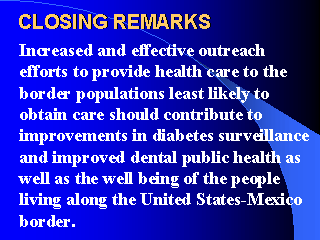
A search of the literature has revealed compelling evidence that
race and ethnicity correlate with persistent, and often increasing, health
disparities among U.S. populations. Indeed, despite notable progress in the
overall health of the United States, there are continuing disparities in the
burden of illness and death experienced by African Americans, Hispanics,
American Indians and Alaska Natives, and Pacific Islanders, compared to the U.S.
population as a whole.
In a February 21, 1998 address to the nation, President Clinton
identified race and ethnicity-related disparities in health outcomes as a major
public health issue in the United States and called for their elimination by the
year 2010. The elimination of these disparities then became the major goal of
the U.S. Department of Health and Human Services' Healthy People 2010. These
initiatives followed years of work by multiple agencies and investigators that
has shown that ethnic minority populations in the United States experience
persistent problems accessing health care, receiving high quality health care,
and achieving health outcomes.
President Clinton's Initiative to eliminate racial and ethnicity
related disparities in health focused on six major areas. These are diabetes,
cardiovascular disease (including stroke), breast and cervical cancer,
HIV-related disease, infant mortality, and immunization rates. These areas were
chosen not only because of differences in outcomes across target populations but
also because primary and secondary prevention strategies have been conclusively
shown to be effective in improving these outcomes.
Diabetes Mellitus is a chronic disease that affects 6% of the
U.S. population. With over 625,000 new cases diagnosed each year, significant
morbidity and mortality, and related health care expenditures of $100 billion
yearly, diabetes continues to be a major health care concern. Patients with
diabetes are at an increased risk of multi-system complications. Recent results
from landmark studies such as DCCT (Diabetes Control and Complications Trial)
and UKPDS
(United Kingdom Prospective Diabetes Study) confirm that intensive therapy,
which achieves more normal glycemia, significantly reduces diabetic
complications.
Diabetes Mellitus is a chronic systemic condition that
constitutes a major public health problem. Diabetes is a serious disease that
can lead to kidney failure, blindness, stroke, heart disease, and lower limb
amputations and is the fourth-leading cause of death in the United States. It
has been estimated that 16 million diabetics live in the United States, 90-95
percent of whom have Type 2 Diabetes Mellitus and 5-10 percent Type 1 Diabetes
Mellitus, and because of its frequency, it is probably the most important
metabolic disease affecting humankind.
Researchers continue to search for the cause or causes of
diabetes and ways to prevent and cure the disorder. Scientists are looking for
genes that may be involved in Type 2 diabetes and Type 1 diabetes. Some genetic
markers for Type 1 diabetes have been identified, and it is now possible to
screen relatives of people with Type 1 diabetes to see if they are at risk for
diabetes. For Type 2 diabetes, the focus is on ways to prevent diabetes.
Preventive approaches include identifying people at high risk for the disorder
and encouraging them to lose weight, exercise more, and follow a healthy diet.
The Diabetes Prevention |
Program, another new National Institute of Diabetes and Digestive and Kidney
Disease of the National Institutes of Health (NIDDK) project, will focus on
preventing the disorder in high-risk populations.
The NIDDK supports basic and clinical research in its own laboratories and in
research centers and hospitals throughout the United States. It also gathers and
analyzes statistics about diabetes. Other institutes at the National Institutes
of Health also carry out research on diabetes-related eye diseases, heart and
vascular complications, pregnancy, and dental problems.
Other Government agencies that sponsor diabetes programs are the Centers for
Disease Control and Prevention, the Indian Health Service, the Health Resources
and Services Administration, the Bureau of Veterans Affairs, and the Department
of Defense. Many organizations outside of the Government support diabetes
research and education activities. These organizations include the American
Diabetes Association, the Juvenile Diabetes Foundation International, and the
American Association of Diabetes Educators (see the URLs at the beginning of
this lecture).
In recent years, advances in diabetes research have led to better ways to
manage diabetes and treat its complications. Major advances include:
- New forms of purified insulin, such as human insulin produced through
genetic engineering.
- Better ways for doctors to monitor blood glucose levels and for people
with diabetes to test their own blood glucose levels at home.
- Development of external and implantable insulin pumps that deliver
appropriate amounts of insulin, replacing daily injections.
- Laser treatment for diabetic eye disease, reducing the risk of blindness.
- Successful transplantation of kidneys in people whose own kidneys fail
because of diabetes.
- Better ways of managing diabetic pregnancies, improving chances of
successful outcomes.
- New drugs to treat Type 2 diabetes and better ways to manage this form of
diabetes through weight control.
- Evidence that intensive management of blood glucose reduces and may
prevent development of microvascular complications of diabetes.
- Demonstration that antihypertensive drugs called ACE-inhibitors prevent or
delay kidney failure in people with diabetes.

|
Go to Comment Form
|
|